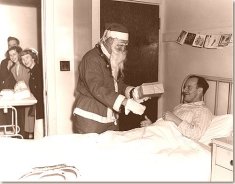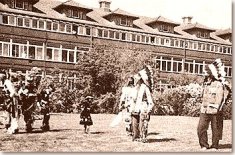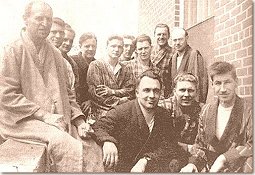The Sanatorium Age |
||||||||||||

|
|
|
||||||||||
|
Fortunate, indeed, were those institutions that provided moral support and made good use of all their facilities for entertainment, as well as diversionary and educational means of passing the time, in order to help make sanatorium life bearable if not even pleasant. It is hard now to realize the months and years that patients spent in these institutions. The marvel is that so many of them stayed the course until success was achieved. The goal of every patient in the sanatorium was to go home as soon as possible. "Chasing cure" meant taking sufficient time in bed, as well as other treatments, and biding your time until the doctor would approve of your health condition. The following poem, written by a sanatorium patient, highlights the one phrase that was on the mind of every patient at every moment. Finally, for each patient the day came when he or she could return to home and family. From this point on, the ex-"cure chaser" would try to re-adjust to regular life, sometimes with a fear of the disease returning, sometimes in a much lower physical condition than before the disease occurred, and sometimes missing a few ribs or a partial lung. However, most patients were just happy to be out of the sanatorium and back on their feet, literally. This patient wrote back, after leaving the sanatorium to encourage other patients about life after the San: "Thankful" Contrary to custom I usually tell my neighbors I had tuberculosis for years. Those, I figure, who tend to avoid me because of ’my case history’ are not worthy of my friendship. You would be surprised how FEW people treat me with less regard on account of this. Frankly, I believe people must be educated to this acceptance of their fellow creatures who unfortunately had tuberculosis at one time. An ex-cure chaser, as you know, is generally not equal to all the demands made upon him by society. I live a quiet life and I let people know in a nice way that thus I wish to live. On the other hand I put so much into my work – time, money, devotion – that I command the respect of all who know me. When people tell me I am too conscientious and generous, I frankly tell them that the people of Saskatchewan spent over $2,000 to bring about my recovery from tuberculosis and, therefore I feel, if I live twenty years longer, it isn’t long enough to pay back in devoted, unselfish service, what I owe the ratepayers for all they did for me when I was ill and helpless. The above little story I hope will help you to help some other ex-patients to see how satisfying one’s life can be, even after having had tuberculosis, if one adjusts oneself to circumstances without hiding one’s past. Old age, for an ex-tuberculosis patient, holds no terrors if one believes in the brotherhood of man, loves whole-heartedly and works happily, because it makes everybody anxious to be all that they can be to the one whose past life was halted and maimed for a while by tuberculosis. This I have proved in my case.An excerpt from a letter written by an ex-patient of a Saskatchewan Sanatorium, taken from the 1950 Valley Echo [vol. 31(12), page 6]. | ||||||||||||




